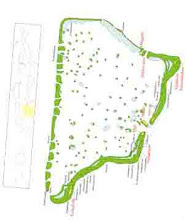
Approximately four hundred years ago the Portuguese landed on a sea promontory near a temple. They asked the local inhabitants the name of the land, but the locals misunderstood, thinking that the Portuguese were asking for the name of the temple. So they answered 'Ma Ge', which was the name of the temple. Later, the Portuguese translated the named into 'Macau' and used it to refer to the land. In actuality, this temple is one of the three famous Buddha halls in Macau- the A-Ma Temple. It wasn’t just for this story, but the A-Ma temple was my favorite place in Macau when I visit it. The A-Ma Temple, located in the southeast of the Macau Peninsula, is the oldest temple in Macau. It was constructed in the year of 1488 of the Ming Dynasty (1368-1644) to commemorate Mazu, the sacred sea goddess who blesses the fishermen of Macau. It is said that the goddess was called Lin Mo, and that she was born in Putian City, Fujian Province, and was more intelligent than other children her age. She could predict good or ill luck and after her death she often helped merchants and fishermen ward off calamities and turn danger into safety. The A-Ma Temple is a destination offering silence and spectacular views. The temple contains six main parts, all of which make up a series of classical Chinese architectural treasures, and this is all guarded by stone lions. Entering the temple and going across a gateway, you will reach the Hongren Hall by a winding path. A statue of Mazu is worshipped here, and it is believed that the hall has the longest history in the complex. Going ahead, the Hall of Avalokitesvara will present itself to visitors. It was constructed mainly using bricks and stone in a simple style. Compared with the other halls, the Zhengjiao Chanlin (a Buddhist hall) was designed tastefully both in regards to size and architectural style. Containing not only an ancient architectural complex, the temple also possesses a measure of the rich and profound Chinese culture. It is worth your while to stay and enjoy the various poems and inscriptions carved on the stone along the cliff. Furthermore, each year, on the days of the birthday of Mazu and the Chinese New Year, many male and female disciples gather here. They burn lots of incense to pay homage and pray for good fortune. I’ left a written wish too, but it is still incomplete. I think I have to return and ask Mazu to remember it.
















1 comentário:
....sometime next year, perhaps?
Enviar um comentário